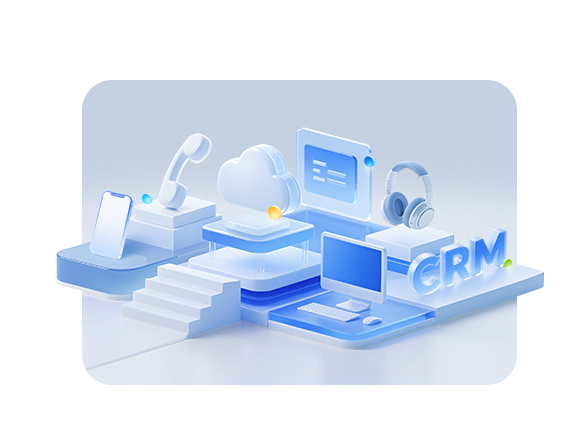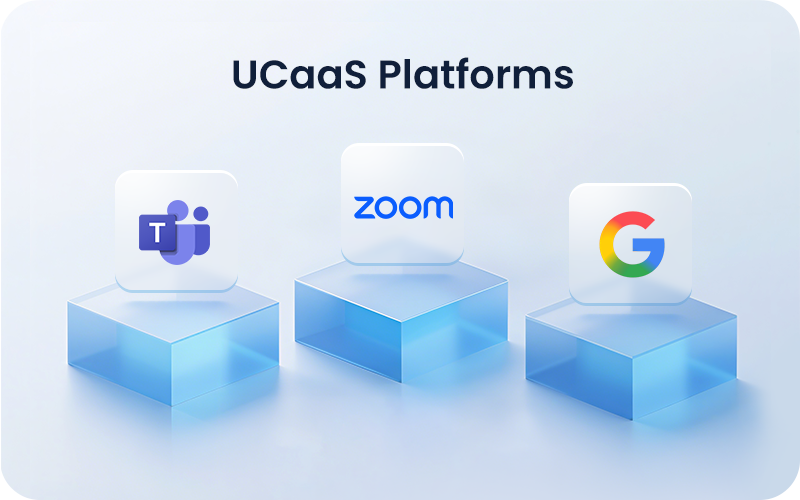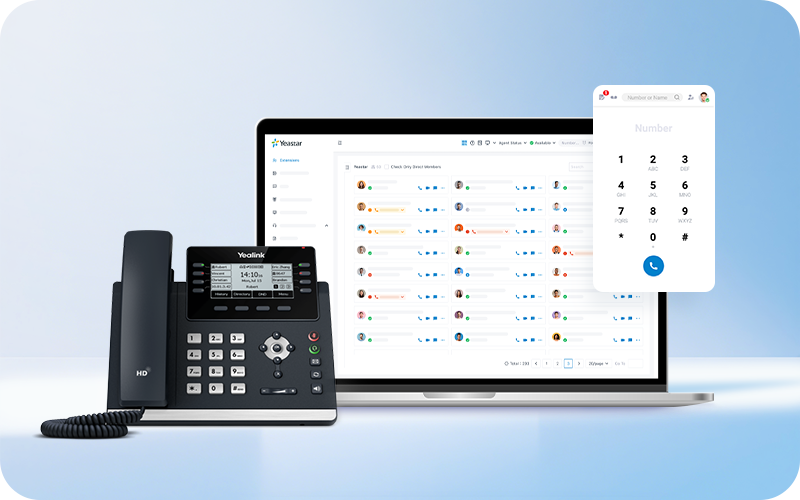
Communication is the lifeline of every business. Poor communication skills can hold employees back, and inefficient collaboration can cost companies both time and money.
That’s why having a unified platform to manage both internal and external communication has become critical for modern businesses. From team collaboration to customer engagement, the right tools can directly impact productivity, customer satisfaction, and overall growth.
But here comes the challenge: which type of communication solution should we adopt? What’s the difference between them? And which one is the best fit for our needs?
In this article, we’ll break down the 4 main types of business communication solutions—UCaaS, CCaaS, VoIP/SIP business phone systems, and CRM, then guide you in finding the right solutions based on your needs.
Jump To:
- Definition of Business Communication Solutions →
- The 4 Main Types of Business Communication Solutions →
- Choose the Right Business Communication Solution →
- Free-Trial with Yeastar P-Series Phone System →
Definition of Business Communication Solutions
Understanding Business Communication
Before exploring the different solutions, it’s important to understand the foundation: business communication. At its core, it’s simply how people exchange information at work.
- Internal communication: Employees chat with each other, share documents, hold meetings, and collaborate on projects.
- External communication: Companies interact with customers, respond to support requests, deliver sales demos, and coordinate with partners.
What Are Business Communication Solutions?
Business Communication Solutions are platforms or suites of tools that bring internal and external communication together in one place. They allow employees and customers to connect through the most convenient channels—chat, calls, video, email, and even omnichannel interactions.
- Internal communication solutions: Instant messaging, team chat, video meetings, file sharing, and project collaboration tools that keep employees connected and productive—whether in the office or working remotely.
- External communication solutions: Customer calls, video consultations, emails, live chat, social media, and CRM integrations that empower businesses to engage customers on their preferred channels.
By unifying these functions, business communication solutions help organizations reduce tool fragmentation, streamline workflows, and create a more seamless experience for both employees and customers.

The 4 Main Types of Business Communication Solutions
While the market offers endless options—ranging from business chat apps and project management tools to AI assistance—most can be grouped into a few major categories. Below, we’ll introduce the four essential communication solutions that unify company communications today: UCaaS, CCaaS, VoIP/SIP, and CRM.
UCaaS (Unified Communications as a Service)
UCaaS is one of the most popular business communication solutions today. It is a cloud-based communications solution that unifies voice, video, messaging, file sharing, and collaboration tools into one workspace. Unlike traditional telephony or standalone apps, UCaaS is designed to support seamless teamwork—whether it’s a group chat, a video meeting, or multiple colleagues co-editing a proposal document in real time. This makes it especially valuable for flexible and hybrid workplaces in the post-COVID era.
Built on cloud infrastructure and WebRTC technology, UCaaS applications are powerful with these features:
- Instant messaging and team chat
- Real-time voice and video calling
- Video conferencing and webinar hosting
- File sharing and collaborative document editing
- Ecosystem integration with productivity suites like Office 365
And at the same time, most UCaaS platforms are delivered as subscription-based business communication solutions, billed monthly or annually. This makes them ideal for startups and organizations seeking a flexible, cost-effective way to start or scale their business communications.

CCaaS (Contact Center as a Service)
CCaaS has revolutionized how businesses manage customer interactions. It is a cloud-based contact center solution that unifies all customer communication channels—including hardware/software phone, email, chat, social media, and SMS—into a single, intelligent platform.
Unlike traditional call centers or standalone support tools, CCaaS is designed to deliver seamless customer experiences—whether it’s automatically routing a complex query to a specialized agent, providing self-service options through AI-powered bots, or maintaining consistent conversation history across all channels. This makes it particularly valuable for businesses prioritizing customer communication satisfaction in the digital age.
Key features include:
- Omnichannel engagement management across voice, email, chat, and social media
- Intelligent routing based on skills, language proficiency, and customer value
- AI-powered self-service through conversational IVR and chatbots
- Real-time performance monitoring and historical analytics
- Seamless CRM integration for contextual customer interactions
CCaaS solutions excel in managing customer communications, particularly in industries with high-demand hotline services such as hospitality, retail, and healthcare. These sectors require efficient, reliable, and multi-channel support to ensure seamless customer experiences.
Meanwhile, UCaaS platforms nowadays typically operate on a pay-as-you-go subscription model with cloud-based deployment, offering modern businesses a more flexible, cost-effective, and convenient solution for internal and external business communications needs.

VoIP & SIP Business Phone System
Today’s business phone systems have evolved far beyond traditional landlines. VoIP (Voice over Internet Protocol) and SIP (Session Initiation Protocol) technologies form the foundation of modern cloud-based business phone system, enabling organizations to make and receive calls over the internet with superior clarity and functionality.
Unlike legacy hardware-dependent systems, these solutions transform voice communications into flexible digital services that integrate seamlessly with other business communication applications. SIP Trunking serves as a bridge technology, connecting existing on-premise PBX systems to the cloud, while full VoIP systems operate entirely in the cloud.
Core Phone System Features:
- HD Voice & Video Calling: Crystal-clear audio and video quality from any internet-connected device
- Virtual Number Management: Acquire and manage local, toll-free, and international numbers without physical hardware
- Professional Call Handling: Automated attendants, multi-level call queues, and intelligent call routing
- Unified Device Support: Seamless operation across IP desk phones, desktop apps, and mobile applications
- Hybrid Deployment Options: SIP Trunking enables gradual migration from traditional to cloud-based systems
Modern business phone systems operate on a predictable per-user monthly subscription model, eliminating large upfront investments. This makes them particularly valuable for businesses with high-volume calling requirements—including customer support centers, sales teams, and service-based organizations.

CRM (Customer Relationship Management) Systems
A CRM (Customer Relationship Management) system stands apart from other business communication solutions as the central system for customer engagement. It helps in managing business relationships and interactions with current and potential customers.
As the strategic core of modern business operations, CRM systems integrate sales, marketing, and customer service functions into a unified framework that enables organizations to deliver personalized, efficient, and data-driven customer experiences.
Key features include:
- Centralized customer database
- Sales pipeline and deal tracking
- Run email campaigns and track lead sources
- Customer support and ticketing
- Customer interactions data analytics and reporting
CRM systems enhance sales efficiency, improve customer experience, and support team collaboration with these features. They have become indispensable for any customer-facing business aiming to streamline processes and grow sustainably.

Choose the Right Business Communication Solution
While the four main types of solutions each excel in different business communications scenarios, choosing the right one requires a balanced approach. It’s not about a single factor, but a combination of needs, goals, and context. Below is a practical and flexible framework to help you make the best choice for your organization.
1. Identify Your Core Business Needs
Start by pinpointing the primary business challenge you aim to solve. Each type of solution serves distinct scenarios:
- If your focus is internal collaboration and team collaboration: Look for Unified Communications as a Service (UCaaS) platforms that integrate messaging, video meetings, file sharing, and collaborative workspaces. Examples: Microsoft Teams, Slack, or Zoom.
- If customer communication and support are your top priorities: Consider Contact Center as a Service (CCaaS) solutions that unify voice, email, live chat, social messaging, and CRM integration. Examples: Zendesk, Twilio, or Yeastar Linkus.
- If managing customer relationships and sales processes is essential: Invest in a dedicated Customer Relationship Management (CRM) system to centralize customer data and automate workflows. Examples: Salesforce, HubSpot, or Zoho CRM.
While many modern platforms offer overlapping functionalities—like voice features in Teams, ticketing in Zendesk, and Yeastar Linkus UC Clients also integrated with contact center &CRM system—defining your primary need helps avoid overcomplication or redundant tools.
2. Evaluate Regional Compliance and Local Support
Data compliance and local service capabilities are critical—especially for businesses operating across borders. Choose providers that offer local data centers and in-region technical support in your operating areas.
- For Europe and North America: Opt for globally compliant providers like Microsoft Teams, Zoom, or Salesforce, which adhere to standards like GDPR and offer extensive server coverage.
- For emerging markets (Southeast Asia, Latin America, etc.): Prioritize providers with robust local infrastructure and partnership networks, like Zoom, AWS Connect, or regional specialists.
3. Decide on a Deployment Model: Cloud or On-Premises
Your choice of deployment impacts cost, control, and flexibility:
- Cloud-Based (SaaS): Ideal for most companies. Offers quick setup, lower initial costs, seamless updates, and easy scalability—perfect for supporting hybrid and remote work. Most UCaaS, CCaaS, and CRM platforms are cloud-native.
- On-Premises: Best suited for businesses with strict data governance needs, deep customization requirements, or existing legacy systems (e.g., traditional PBX). Examples include self-hosted CRM solutions or SIP trunking integrations.
4. Understand the Total Cost of Ownership (TCO)
Price shouldn’t be the only factor, but it must be part of your long-term planning. Beyond per-user monthly fees, consider:
- Implementation and integration costs: Will you need custom development to connect with existing tools (e.g., ERP)?
- Training and change management: Is the tool user-friendly? How much training will your team need?
- Ongoing support and upgrades: What’s included in technical support? What are the costs for adding new features or users later?
Choosing the right business communication solution is a multi-dimensional decision that requires careful consideration. When you’re not fully sure which option fits best, taking advantage of free trials and demos is a practical way to explore the tools firsthand and validate their value with your team.
Free-Trial with Yeastar P-Series Phone System
Yeastar P-Series Phone System goes beyond a traditional business phone system. It unifies voice, video, messaging, and customer engagement tools into one platform—making it a flexible, future-ready solution for companies of all sizes.
Highlights include:
- Seamless Calling Experience: High-quality native voice and video calls, enhanced with AI-powered transcription and translation.
- Advanced Call Handling: IVR, queues, ring groups, call routing, and built-in contact center features for high-volume communication needs.
- Omnichannel Engagement: Connect with customers via WhatsApp, Facebook, SMS, and even run outbound campaigns—all without leaving the system.
- CRM & Helpdesk Integrations: Open APIs to integrate with Salesforce, Zoho, Zendesk, and more, extending capabilities beyond calls.
- Visual Automation with Call Flow Designer: Design smart call flows in minutes to automate repetitive processes.
- Work Anywhere: Linkus UC Clients on desktop, web, and mobile keep your team connected from the office or on the go.
Trusted across industries including hospitality, education, finance, healthcare, retail and more. Start your free trial or book a demo to see how Yeastar P-Series can simplify and elevate your business communications.

